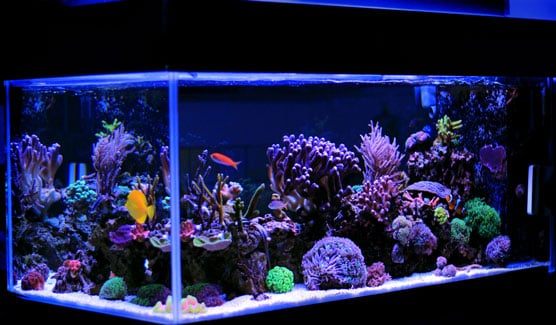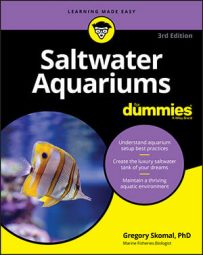 ©Vojce/Shutterstock.com
©Vojce/Shutterstock.comMaintenance Schedule for Your Saltwater Aquarium
To keep the fish and other marine life in your saltwater aquarium happy and healthy, you have to do some basic maintenance. Some tasks you need to do every day without fail; other jobs you do weekly, bi-weekly, or monthly. And every three months you need to conduct a thorough examination of all aquarium systems, including lighting, heating, filtration, sump, powerheads, aeration pumps, and tubing. Replace or clean parts as needed.
The following table shows the tasks to do on a continuing basis:
| Every Day | Once a Week | Every Two Weeks | Every Month |
| Turn the lights on and off. Most aquarists prefer to use an automatic timer. If you choose not to, try to turn the lights on and off in a consistent pattern. | Remove excess algae, keeping beneficial algae at acceptable levels and getting rid of nuisance algae. | Clean filters as needed. Partially change or rinse the filter media on some filters if the bioload is high, the media is dirty, or the flow is restricted. | Conduct thorough filter checks. Replace the filter carbon and rinse the filter media and components, as needed and depending on bioload. |
| Observe your fish and invertebrates for signs of stress, disease, or death. Be prepared to remove or treat fish that aren’t well. | Clean the glass, both inside and out; remove salt-creep deposits. | Change twenty percent of the tank water while vacuuming the gravel. | Clean the protein skimmer. |
| Feed the fishes and invertebrates twice a day, removing any uneaten food. Some fishes might require more frequent feeding, while others not so much. Make every effort to cater to the needs of each species. | Conduct all water tests weekly after the water matures and the nitrogen cycle is established; include alkalinity, calcium, and phosphate. Record all test results and add trace elements and buffers as needed. | Replace airstones as needed. | |
| Conduct water tests until the water matures and the nitrogen cycle is established. Routine tests include ammonia, nitrite, nitrate, and pH. Record the test results. | Clean the outside of the aquarium, removing salt and calcium deposits, dust, and dirt. | ||
| Check the water temperature and specific gravity or salinity. Adjust the heater as needed. | Rinse any tank decorations that suffer from excess algae. | ||
| Empty the protein skimmer collection cup as needed. | |||
| Check the water level and top off as needed. | |||
| Check all aquarium systems: heater, filters, aerators, protein skimmer, sump. Make sure they’re running properly and smoothly and pay special attention to intakes and siphon tubes. Make sure nothing is leaking. |
How to Feed the Fish in Your Saltwater Aquarium
Develop a working sense of how much and how often to feed the fish and invertebrates in your saltwater aquarium. Use the guidelines in the following list and keep in mind that it’s definitely better to feed them too little than too much.
- Offer as much food as your fish will eat in five minutes. Food should sink no deeper than one third the height of the tank. Provide tablets, pellets, or sinking food for bottom fish and invertebrates.
- Feed your food in very small portions over the five-minute period. If any food is left over after this time, you are an overfeeder.
Some foods, such as lettuce and spinach, are nibbled over time, so the five-minute rule doesn’t apply.
- If you’re home during the day, feed your fish and invertebrates very small portions over the course of the day. If you’re not home, feed them twice a day at the same times every day, once in the morning at once at night. Keep in mind that some critters are nocturnal, so you may have to feed them after the lights are out.
- Always feed your fish at the same spot in the tank. This lets you sneak food down to the bottom dwellers, while the surface fish are distracted.
- Don’t overfeed the fish, no matter how much you think they need more food. Overeating stresses your fish and causes detritus to accumulate in the tank, degrading water quality.
Test Kits for Testing Water in Saltwater Aquariums
You can’t visually determine the pH balance of the water in your saltwater aquarium. To maintain healthy levels of chemicals and minerals in the saltwater aquarium, you have to test the water, and to do that, you have to buy test kits for saltwater aquariums. Here’s a general guide for purchasing test kits for your fish-only or reef tank. As your tank becomes more complicated, you can always add to your test-kit collection.
| Test Kit | Fish-Only Tank | Reef Tank |
| pH | yes | yes |
| Ammonia | yes | yes |
| Nitrite | yes | yes |
| Nitrate | yes | yes |
| Alkalinity | optional | yes |
| Dissolved oxygen | optional | optional |
| Copper | optional | no |
| Phosphate | optional | yes |
| Iodine | no | optional |
| Calcium | no | yes |
| Silica | no | optional |
Test kits are made so you don’t have to be a chemist to use them. Although a couple of methods have been developed, the most common involves adding drops of the test chemical to an aquarium sample that changes the color of the water. You then match the watercolor with that on a color chart, which tells you the correct level of what you are testing.

